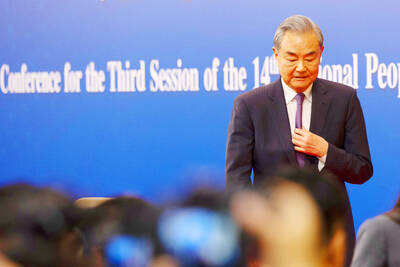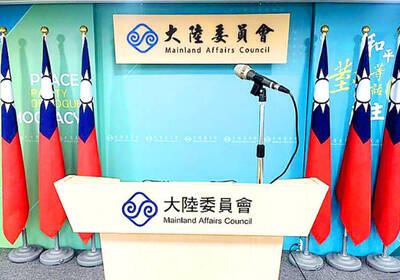South Korea closed schools yesterday and its factories producing memory chips stepped up safeguards as a choking pall of sand mixed with toxic dust from China covered most of the country and other parts of Asia.
The annual "yellow dust" spring storms, which originate in the Gobi Desert in China before sweeping south to envelop the Korean Peninsula and parts of Japan, are blamed for scores of deaths and billions of dollars in damage every year in South Korea.
Seoul issued a yellow dust warning at the weekend. Yesterday, school districts in southeastern regions urged parents to keep kindergarten and elementary school children at home.
"We advised the closure because kindergarten, primary school students have weaker immune systems," said Min Eyu-gi, an education official in Busan.
An official with the Meteorological Administration said the first major storm of the season, which has also hit parts of Japan, was dissipating.
But forecasts from China said cold air and little rainfall would lead to more storms from tomorrow through next Tuesday, Xinhua news agency reported.
Taiwan mostly avoided the toxic clouds, but skies in Taipei yesterday were overcast, with the government telling people to wear surgical masks and avoid exercising outdoors.
In Japan, car drivers and train operators were asked to be on alert because the sandstorms had greatly reduced visibility.
Japanese Environment Minister Ichiro Kamoshita recently called on Beijing to disclose data on the yellow sand.
"About yellow sand, I am not quite sure how and why it can be regarded as a national secret," Kamoshita told a press conference last month.
"Air is connected beyond national borders and yellow sand travels beyond borders. I think it is important we share information," he said.
The sand storms have increased in frequency and toxicity over the years because of China's rapid economic growth and have added to growing tensions with its neighbors South Korea and Japan.
The dust picks up heavy metals and carcinogens, such as dioxin, as it passes over Chinese industrial regions, before hitting North and South Korea and Japan, meteorologists say.
Dry weather and seasonal winds in China hurl millions of tonnes of sand at the Korean Peninsula and Japan from late February through April or May, turning the skies to a jaundiced hue.
The state-sponsored Korea Environment Institute said the dust kills up to 165 South Koreans a year, mostly the elderly or those with respiratory ailments and makes as many as 1.8 million ill.
Annual economic damage to South Korea from the storms is estimated at up to 5.5 trillion won (US$5.82 billion), the institute said.
Hynix Semiconductor Inc, the world's second-largest maker of memory chips, said it had stepped up its filtration systems and made employees take longer air showers to make sure the dust does not contaminate its production lines and damage chips, which are made using technology that operates on a microscopic level.
South Korean retailers, however, have spotted an opportunity, offering special scarves, hats and other accessories for the yellow dust season.
Also see: Feared dust cloud not as severe as forecast, says EPA

‘DANGEROUS GAME’: Legislative Yuan budget cuts have already become a point of discussion for Democrats and Republicans in Washington, Elbridge Colby said Taiwan’s fall to China “would be a disaster for American interests” and Taipei must raise defense spending to deter Beijing, US President Donald Trump’s pick to lead Pentagon policy, Elbridge Colby, said on Tuesday during his US Senate confirmation hearing. The nominee for US undersecretary of defense for policy told the Armed Services Committee that Washington needs to motivate Taiwan to avoid a conflict with China and that he is “profoundly disturbed” about its perceived reluctance to raise defense spending closer to 10 percent of GDP. Colby, a China hawk who also served in the Pentagon in Trump’s first team,

SEPARATE: The MAC rebutted Beijing’s claim that Taiwan is China’s province, asserting that UN Resolution 2758 neither mentions Taiwan nor grants the PRC authority over it The “status quo” of democratic Taiwan and autocratic China not belonging to each other has long been recognized by the international community, the Mainland Affairs Council (MAC) said yesterday in its rebuttal of Beijing’s claim that Taiwan can only be represented in the UN as “Taiwan, Province of China.” Chinese Minister of Foreign Affairs Wang Yi (王毅) yesterday at a news conference of the third session at the 14th National People’s Congress said that Taiwan can only be referred to as “Taiwan, Province of China” at the UN. Taiwan is an inseparable part of Chinese territory, which is not only history but

CROSSED A LINE: While entertainers working in China have made pro-China statements before, this time it seriously affected the nation’s security and interests, a source said The Mainland Affairs Council (MAC) late on Saturday night condemned the comments of Taiwanese entertainers who reposted Chinese statements denigrating Taiwan’s sovereignty. The nation’s cross-strait affairs authority issued the statement after several Taiwanese entertainers, including Patty Hou (侯佩岑), Ouyang Nana (歐陽娜娜) and Michelle Chen (陳妍希), on Friday and Saturday shared on their respective Sina Weibo (微博) accounts a post by state broadcaster China Central Television. The post showed an image of a map of Taiwan along with the five stars of the Chinese flag, and the message: “Taiwan is never a country. It never was and never will be.” The post followed remarks

INVESTMENT WATCH: The US activity would not affect the firm’s investment in Taiwan, where 11 production lines would likely be completed this year, C.C. Wei said Investments by Taiwan Semiconductor Manufacturing Co (TSMC, 台積電) in the US should not be a cause for concern, but rather seen as the moment that the company and Taiwan stepped into the global spotlight, President William Lai (賴清德) told a news conference at the Presidential Office in Taipei yesterday alongside TSMC chairman and chief executive officer C.C. Wei (魏哲家). Wei and US President Donald Trump in Washington on Monday announced plans to invest US$100 billion in the US to build three advanced foundries, two packaging plants, and a research and development center, after Trump threatened to slap tariffs on chips made